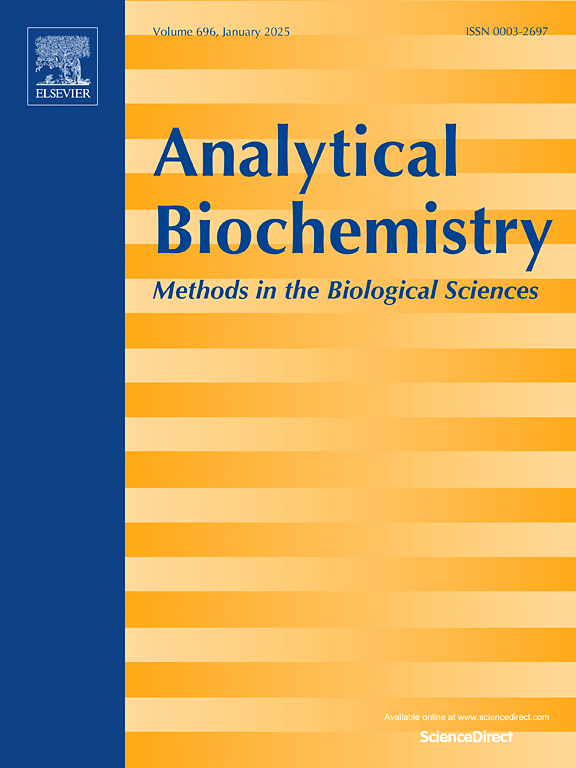Lateral flow immunoassay based on aggregation induced emission nanobeads for the sensitive and accurate detection of chloramphenicol in pig hair
IF 2.5
4区 生物学
Q2 BIOCHEMICAL RESEARCH METHODS
引用次数: 0
Abstract
Chloramphenicol (CAP) is a once widely used antibiotic, which is able to cause great harm to human health, is banned in some countries or organizations such as China, USA and the European Union for animal breeding. Because CAP in pig hair degraded slower and had amount of residues, pig hair could be used as the target to detect CAP residues. In this study, a competitive lateral flow immunoassay (LFIA), whose label was aggregation induced emission fluorescent nanobeads (AIEFN), was firstly developed for the detection of CAP in pig hair samples. It exhibited a low limit of detection (0.001 μg/kg) and a broad linear range (0.0025–0.32 μg/kg). The recovery rate and coefficient variation with spiked pig hair samples were 88.50%–106.17 % and 1.01%–7.37 %, which indicated good accuracy of this assay. The result of AIEFN-LFIA for the detection of CAP in pig hair was consistent with that of liquid chromatography-mass spectrometry. This assay was rapid with the total detection duration of about 20 min. AIEFN-LFIA was able to be used for rapid, sensitive, accurate and convenient detection of CAP residues in pig hair samples.
基于聚集诱导发射纳米微球的横向流动免疫分析法灵敏、准确地检测猪毛中氯霉素。
氯霉素(Chloramphenicol, CAP)是一种曾经广泛使用的抗生素,对人体健康有很大的危害,在中国、美国、欧盟等一些国家或组织禁止用于动物养殖。由于猪毛中CAP降解较慢且残留量大,猪毛可作为检测CAP残留量的靶标。本研究首次建立了一种竞争性横向流动免疫分析法(LFIA),其标记为聚集诱导发射荧光纳米粒(AIEFN),用于检测猪毛样品中的CAP。该方法检出限低(0.001 μg/kg),线性范围宽(0.0025 ~ 0.32 μg/kg)。加标猪毛样品的回收率为88.50% ~ 106.17%,变异系数为1.01% ~ 7.37%,准确度较高。AIEFN-LFIA法检测猪毛中CAP的结果与液相色谱-质谱法一致。该方法快速,总检测时间约为20 min。AIEFN-LFIA能够快速、灵敏、准确、方便地检测猪毛中CAP残留。
本文章由计算机程序翻译,如有差异,请以英文原文为准。
求助全文
约1分钟内获得全文
求助全文
来源期刊

Analytical biochemistry
生物-分析化学
CiteScore
5.70
自引率
0.00%
发文量
283
审稿时长
44 days
期刊介绍:
The journal''s title Analytical Biochemistry: Methods in the Biological Sciences declares its broad scope: methods for the basic biological sciences that include biochemistry, molecular genetics, cell biology, proteomics, immunology, bioinformatics and wherever the frontiers of research take the field.
The emphasis is on methods from the strictly analytical to the more preparative that would include novel approaches to protein purification as well as improvements in cell and organ culture. The actual techniques are equally inclusive ranging from aptamers to zymology.
The journal has been particularly active in:
-Analytical techniques for biological molecules-
Aptamer selection and utilization-
Biosensors-
Chromatography-
Cloning, sequencing and mutagenesis-
Electrochemical methods-
Electrophoresis-
Enzyme characterization methods-
Immunological approaches-
Mass spectrometry of proteins and nucleic acids-
Metabolomics-
Nano level techniques-
Optical spectroscopy in all its forms.
The journal is reluctant to include most drug and strictly clinical studies as there are more suitable publication platforms for these types of papers.
 求助内容:
求助内容: 应助结果提醒方式:
应助结果提醒方式:


